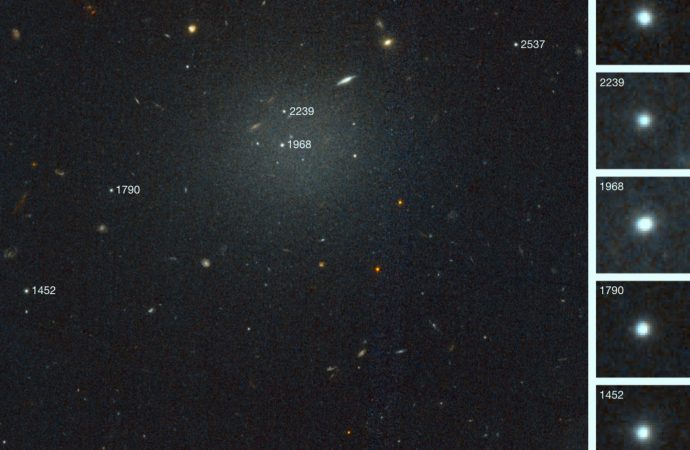In 2018, a team of astronomers from the United States and Canada discovered that an ultra-diffuse galaxy called NGC 1052-DF2 (DF2 for short) contains virtually no dark matter. The galaxy is roughly the size of our Milky Way Galaxy, but hosts only 1/200 the number of stars. It lies in the constellation of Cetus, about 65 million light-years away, and is a member of the NGC 1052 group of galaxies. Now, the team reports the discovery of a second galaxy in this class, residing in the same group.
Source: Sci News
“Discovering a second galaxy with very little to no dark matter is just as exciting as the initial discovery of DF2,” Yale University’s Professor Pieter van Dokkum.
“This means the chances of finding more of these galaxies are now higher than we previously thought. Since we have no good ideas for how these galaxies were formed, I hope these discoveries will encourage more scientists to work on this puzzle.”
The newly-discovered galaxy, named NGC 1052-DF4 (DF4 for short), resembles DF2 in terms of its size, brightness, and morphology, and has a similar distance of 65 million light-years.
“Like DF2, it belongs to a recently-discovered class of galaxies called ultra-diffuse galaxies (UDGs),” the astronomers said.
“They are as large as the Milky Way but have between 100 to 1,000 times fewer stars, making them appear fluffy and translucent, therefore difficult to observe.”
“Ironically, the lack of dark matter in these UDGs strengthens the dark matter theory. It proves that dark matter is a substance that is not coupled to normal matter, as both can be found separately.”
“The discovery of these galaxies is difficult to explain in theories that change the laws of gravity on large scales as an alternative to the dark matter hypothesis.”
The team also confirmed their initial observations of DF2, which show dark matter is practically absent in the galaxy.
Using W. M. Keck Observatory’s Keck Cosmic Web Imager, they gathered more precise measurements and found that the globular clusters inside the galaxy are indeed moving at a speed consistent with the mass of the galaxy’s normal matter. If there were dark matter in DF2, the clusters would be moving much faster.
“We hope to next find out how common these galaxies are and whether they exist in other areas of the Universe,” said Shany Danieli, a graduate student at Yale University.
“We want to find more evidence that will help us understand how the properties of these galaxies work with our current theories.”
“Our hope is that this will take us one step further in understanding one of the biggest mysteries in our Universe — the nature of dark matter.”
The team’s results were published in two papers in the Astrophysical Journal Letters.

































Leave a Comment
You must be logged in to post a comment.